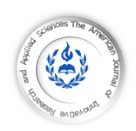


American Journal of Innovative Research & Applied Sciences

Informations Authors
Instituations Affiliations:
Department of Biochemistry | Collage of Medicine and Allied Health Professions | Federal University | Dutse | Nigeria |
Department of Biochemistry | Collage of Medicine and Allied Health Professions | Federal University | Dutse | Nigeria |

Authors Copyright © 2015: | Labaran Ibrahim |
| | ABSTRACT | Volume 1, Issue 5, Pages 193-196 (July 2015) |
| Research article ASSESSMENT OF BIOACCUMULATION OF SOME HEAVY METALS IN TILAPIA ZILLI AND CLARIAS ANGUILLARIS FROM WUDIL RIVER, KANO-NIGERIA | Labaran Ibrahim |. The American Journal of Innovative Research and Applied Sciences. 2015; 1(5)193-196. |PDF FULL TEXT| |
| ABSTRACT Background: Heavy metals are metallic chemical elements with a relatively density and toxic or poisonous to health because they are not degraded by the living body, hence, tends to accumulate over time. Objectives: This study was undertaken to determine the levels or concentrations of some heavy metals; Lead (Pb), Nickel (Ni), Cadmium (Cd), Iron (Fe) and Zinc (Zn) in the two (2) fish species; Tilapia zilli and Clarias anguillaris with weight of 95.00g and 98.98g respectively, obtained from Wudil-river, Kano-Nigeria. Methods: The mean concentrations of the heavy metals present were determined using PerkinElmer Analyst 300 Atomic Absorption Spectroscopy (AAS). A calibration plot of absorbance against concentration of each element under investigation was constructed and finally the concentration of each element was determined from calibration curve by extrapolation. Results: The results of this work indicated that the concentrations of (Pb) was found to be 0.34 mgdm-3, (Ni) 1.15 mgdm-3, (Cd) 1.42 mgdm-3, (Fe) 1.42 mgdm-3, and (Zn) 1.20 mgdm-3 in Tilapia zilli, while, (Pb) concentrations in Clarias anguillaris was found to be 0.30 mgdm-3, (Ni) 2.01 mgdm-3, (Cd) 1.14 mgdm-3, (Fe) 2.42 mgdm-3, and (Zn) 1.30 mgdm-3 respectively. The concentrations of Pb, Ni, Cd, and Fe in both specie of fishes were above the permissible limits of 0.05mg/dm3, 0.02mg/dm3, 0.80mg/dm3 0.30mg/dm3 respectively as recorded by United States Environmental Protection Agency (USEPA) and World Health Organization (WHO). However, (Zn) concentrations in two fishes were found to be below the permissible limits of 2.91mg/dm3 sets for heavy metals by the above named organizations. Conclusion: Therefore, the results of this work revealed clearly that the concentration of Pb, Ni, Cd, and Fe accumulated in the two fishes may be toxic or detrimental to health, since above the tolerable or permissible limits. Keywords: Fish species, Concentrations, Permissible limits, Results, Absorbance, Cadmium |
| www.american-jiras.com | Copyright © 2014, ajiras, Atlantic Centre for Research Sciences, All Rights Reserved |
| Web Site Form: v 0.1.03 | JF 22 Cours, Wellington le Clairval, Lillebonne | France |
| Web Site Form: v 0.1.03 | JF 22 Cours, Wellington le Clairval, Lillebonne | France |
This article is made freely available as part of this journal's Open Access.
Share us on Social Media Links:
| HOME | ABOUT US | ARCHIVE | AIMS AND SCOP | AUTHORS | REVIEW | SUMIBMIT MANUSCRIPT | EDITORIAL BOARED | |




ResearchBib, Google Scholar, SIS database, i.f.s.i.j, Scribd, IISJ, Eurasian Scientific Journal Index (ESJI), Indianscience.in, arastirmax, Directory of Research Journals Indexing, Pak Academic Sesearch, AcademicKeays, CiteSeerX, UDL Library, CAS Abstracts, J-Gate, WorldCat, Scirus, IET Inspec Direct, and getCited

American Journal of innovative
Research & Applied Sciences
Research & Applied Sciences
Indexed by:
ISSN 2429-5396 (Online)
| HOME || ABOUT US || ARCHIVES || AIMS AND SCOP || AUTHORS || REVIEW|| SUBMIT MANUSCRIPT || EDITORIAL BOARD || CAREER and JOB |